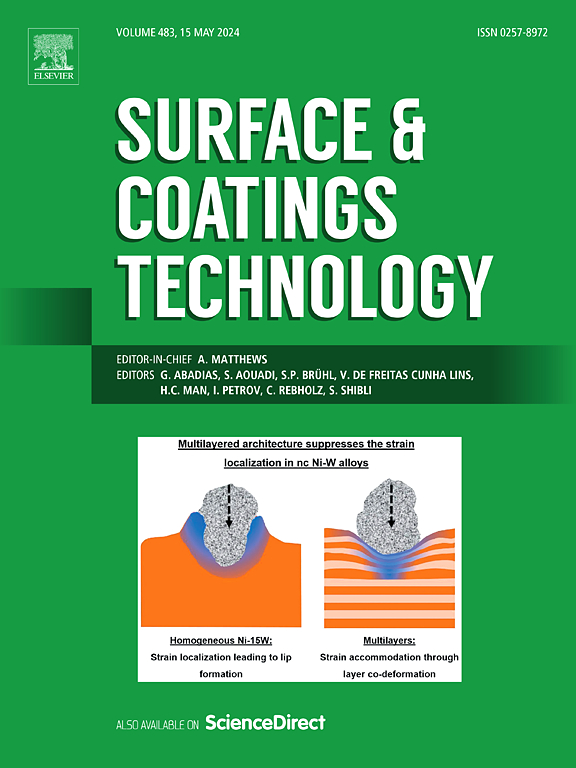Effect of Si and Cr on formation of aluminide coatings on Ti6Al4V alloy by low temperature aluminizing: Wear and oxidation behavior
IF 5.3
2区 材料科学
Q1 MATERIALS SCIENCE, COATINGS & FILMS
引用次数: 0
Abstract
To improve the surface properties of the Ti-6Al-4 V titanium alloy, TiAl3-based intermetallic coatings were produced at 710 °C-4 h via a low-temperature aluminizing process. Additionally, Si and Cr were incorporated into the Ti![]() Al coating to investigate their effects on the properties of the Ti
Al coating to investigate their effects on the properties of the Ti![]() Al system. The findings revealed that the coatings formed strong metallurgical bonds with the substrate, and no significant cracks were detected in the Ti
Al system. The findings revealed that the coatings formed strong metallurgical bonds with the substrate, and no significant cracks were detected in the Ti![]() Al system coatings. However, the addition of Cr was found to have a negative effect on the growth of the coating layer. Similarly, the simultaneous addition of Cr and Si reduced the thickness of the layer from 14 μm to 5 μm. An increase of up to 248 GPa elastic modulus (EIT) and 10.36 GPa hardness was achieved with the aluminide coating of Ti6Al4V, which have had 150 GPa EIT and 5.56 GPa hardness. While all coatings provided better wear performance compared to the substrate, the lowest volume loss was observed in the TiAl coating with the highest thickness. Similarly, the best oxidation resistance was obtained in TiAl due to higher coating thickness and lower phase transformation in its coating layer compared to others. The addition of Si and Cr did not affect the formed oxide products, but they decreased the oxidation resistance due to thinner coating structure.
Al system coatings. However, the addition of Cr was found to have a negative effect on the growth of the coating layer. Similarly, the simultaneous addition of Cr and Si reduced the thickness of the layer from 14 μm to 5 μm. An increase of up to 248 GPa elastic modulus (EIT) and 10.36 GPa hardness was achieved with the aluminide coating of Ti6Al4V, which have had 150 GPa EIT and 5.56 GPa hardness. While all coatings provided better wear performance compared to the substrate, the lowest volume loss was observed in the TiAl coating with the highest thickness. Similarly, the best oxidation resistance was obtained in TiAl due to higher coating thickness and lower phase transformation in its coating layer compared to others. The addition of Si and Cr did not affect the formed oxide products, but they decreased the oxidation resistance due to thinner coating structure.
Si和Cr对低温渗铝Ti6Al4V合金铝化物涂层形成的影响:磨损和氧化行为
为了提高ti - 6al - 4v钛合金的表面性能,采用低温渗铝工艺,在710℃-4 h下制备了tial3基金属间化合物涂层。此外,将Si和Cr加入到TiAl涂层中,研究了它们对TiAl体系性能的影响。结果表明,涂层与基体形成了牢固的冶金结合,并且在TiAl系统涂层中没有检测到明显的裂纹。然而,Cr的加入对涂层的生长有负面影响。同样,同时加入Cr和Si使层的厚度从14 μm减小到5 μm。Ti6Al4V铝化物涂层的弹性模量(EIT)提高了248 GPa,硬度提高了10.36 GPa, EIT达到150 GPa,硬度达到5.56 GPa。虽然所有涂层都比基体具有更好的磨损性能,但在厚度最高的TiAl涂层中观察到的体积损失最小。同样,TiAl的抗氧化性能也较好,因为其涂层厚度较高,涂层相变较低。Si和Cr的加入对形成的氧化产物没有影响,但由于涂层结构变薄,其抗氧化性降低。
本文章由计算机程序翻译,如有差异,请以英文原文为准。
求助全文
约1分钟内获得全文
求助全文
来源期刊

Surface & Coatings Technology
工程技术-材料科学:膜
CiteScore
10.00
自引率
11.10%
发文量
921
审稿时长
19 days
期刊介绍:
Surface and Coatings Technology is an international archival journal publishing scientific papers on significant developments in surface and interface engineering to modify and improve the surface properties of materials for protection in demanding contact conditions or aggressive environments, or for enhanced functional performance. Contributions range from original scientific articles concerned with fundamental and applied aspects of research or direct applications of metallic, inorganic, organic and composite coatings, to invited reviews of current technology in specific areas. Papers submitted to this journal are expected to be in line with the following aspects in processes, and properties/performance:
A. Processes: Physical and chemical vapour deposition techniques, thermal and plasma spraying, surface modification by directed energy techniques such as ion, electron and laser beams, thermo-chemical treatment, wet chemical and electrochemical processes such as plating, sol-gel coating, anodization, plasma electrolytic oxidation, etc., but excluding painting.
B. Properties/performance: friction performance, wear resistance (e.g., abrasion, erosion, fretting, etc), corrosion and oxidation resistance, thermal protection, diffusion resistance, hydrophilicity/hydrophobicity, and properties relevant to smart materials behaviour and enhanced multifunctional performance for environmental, energy and medical applications, but excluding device aspects.
 求助内容:
求助内容: 应助结果提醒方式:
应助结果提醒方式:


